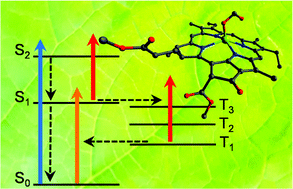Tuning fast excited-state decay by ligand attachment in isolated chlorophyll a†
Abstract
Excited-state dynamics plays a key role for light harvesting and energy transport in photosynthetic proteins but it is nontrivial to separate the intrinsic photophysics of the light-absorbers (chlorophylls) from interactions with the protein matrix. Here we study chlorophyll a (4-coordinate complex) and axially ligated chlorophyll a (5-coordinate complex) isolated in vacuo applying mass spectrometry to shed light on the intrinsic dynamics in the absence of nearby chlorophylls, carotenoids, amino acids, and water molecules. The 4-coordinate complexes are tagged by quaternary ammonium ions while the charge is provided by a formate ligand in the case of 5-coordinate complexes. Regardless of excitation to the Soret band or the Q band, a fast ps decay is observed, which is ascribed to the decay of the lowest excited singlet state either by intersystem crossing (ISC) to nearby triplet states or by excited-state relaxation on the excited-state potential-energy surface. The lifetime of the first excited state is 15 ps with Mg2+ at the chlorophyll center, but only 1.7 ps when formate is attached to Mg2+. When the Soret band is excited, an initial sup-ps relaxation is observed which is ascribed to fast internal conversion to the first excited state. With respect to ISC, two factors seem to play a role for the reduced lifetime of the formate-chlorophyll complex: (i) The Mg ion is pulled out of the porphyrin plane thus reducing the symmetry of the chromophore, and (ii) the first excited state (Q band) and T3 are tuned almost into resonance by the ligand, which increases the singlet–triplet mixing.

- This article is part of the themed collection: 2021 PCCP HOT Articles


 Please wait while we load your content...
Please wait while we load your content...